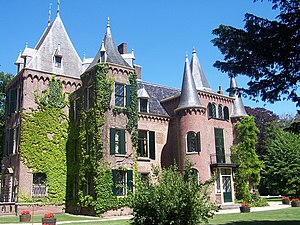Keukenhof


Keukenhof ("Kitchen garden", Dutch pronunciation: [ˈkøːkə(n)ˌɦɔf]), also known as the Garden of Europe, is the world's largest flower garden situated near Lisse, Netherlands. According to the official website for the Keukenhof Park, approximately 7,000,000 (seven million) flower bulbs are planted annually in the park, which covers an area of 32 hectares.[1]
Keukenhof is located in South Holland in the small town of Lisse, south of Haarlem and southwest of Amsterdam. It is accessible by bus from the train stations of Haarlem, Leiden and Schiphol. It is located in an area called the "Dune and Bulb Region" (Duin- en Bollenstreek).
Keukenhof is open annually from mid-March to mid-May. The best time to view the tulips is around mid-April, depending on the weather.
History
Keukenhof is situated on 15th century hunting grounds. It was also a source of herbs for Jacqueline, Countess of Hainaut's castle, which is the source of the name Keukenhof (it served to provide herbs for the castle's kitchen). Rich merchants took over the grounds after the Countess's death. VOC captain and governor Adriaen Maertensz Block lived there in his retirement years in the 17th century in the country house (now known as Castle Keukenhof) which he had let built in 1641.[2]
In the 19th century, the Baron and Baroness Van Pallandt assigned the landscape architect Jan David Zocher and his son Louis Paul Zocher, who had also worked on the Vondelpark, to design the grounds around the castle.[3]
The garden was established in 1949 by the then-mayor of Lisse. The idea was to present a flower exhibit where growers from all over the Netherlands and Europe could show off their hybrids – and help the Dutch export industry (the Netherlands is the world's largest exporter of flowers). Keukenhof has been the world's largest flower garden for over fifty years.
Distinguished Visitors
Many dignitaries have visited the Keukenhof. Queen Juliana was a patron. Her daughters, princesses Beatrix, Irene and Margriet belonged to the first visitors in 1950. As a passionate filmmaker Prince Bernhard shot some unique films. Other members of the Dutch Royal Family also visited the Keukenhof. In 2001 Crown-Prince Willem-Alexander and his fiancee Princess Maxima paid a visit to present themselves to the Dutch population. They planted a Tilla europea, the "Koningslinde".[4]
In the autumn of 2003, Prince Willem-Alexander, together with Olympic medal winners Ankie van Grunsven and Pieter van den Hoogenband, planted the symbolical first bulb for the Olympic rings.[5]
In 2005 the park was opened by Her Royal Highness Princess Margriet.[6]
Inside Exhibitions
In the pavilions flower inspections take place. The most valued entry will be awarded with the Keukenhof Award by the Regular Committee of Inspection. There are awards for tulips, roses, chrysanthemums and many other flowers. A part of the Willem Alexander Pavilion has been planted with summer flowers. It gives an idea how bulbs can be combined.[7]
Gardens
Different gardens and garden styles go hand in hand at the Keukenhof. For example, the English landscape garden with winding paths and unexpected see-through points (designed by Zocher in 1830, the garden architect of the Vondelpark in Amsterdam, among others). There is a Historical Garden, an enclosed garden where you can see many old types of bulbs. You can visit a nature garden, which consists of a water garden, where shrubs and perennials are combined with bulbous plants. And the Japanese country garden, a playful non-traditional garden in a natural environment.[8]
Opening times
Keukenhof is scheduled to be open from 21 March to 20 May 2013.[9] The Flower Parade will be held on 20 April 2013.[9]
The grounds of Castle Keukenhof[10] are open all year long and are frequently used for festivals such as Castlefest, the Ladies Winternight, and Christmas Fair--Zuccheroh (talk) 13:40, 20 September 2012 (UTC).[11] The castle also houses classical music performances.
Gallery
References
- ^ Keukenhof website - Facts and figures
- ^ Template:Nl Landgoed Keukenhof, Buitenplaatseninnederland.nl
- ^ Keukenhof website - History
- ^ Keukenhof - Vol van inspiratie. Lisse: Stichting International Bloemententoonstelling Keukenhof. 2005. p. 48.
- ^ Keukenhof - Vol van inspiratie. Lisse: Stichting International Bloemententoonstelling Keukenhof. 2005. p. 48.
- ^ Keukenhof - Vol van inspiratie. Lisse: Stichting International Bloemententoonstelling Keukenhof. 2005. p. 48.
- ^ Keukenhof - Vol van inspiratie. Lisse: Stichting International Bloemententoonstelling Keukenhof. 2005. p. 48.
- ^ Keukenhof - Vol van inspiratie. Lisse: Stichting International Bloemententoonstelling Keukenhof. 2005. p. 48.
- ^ a b Keukenhof website
- ^ Castle Keukenhof website
- ^ Template:Nl Ladies Winternight Keukenhof
External links
- Keukenhof - Official Website of Keukenhof Park
- Keukenhof Gardens Creative Commons Photo Slideshow
- Keukenhof Gardens Photos
- Keukenhof Gardens High Res. Photos
- Keukenhof Christmas Fair - Official Website of Keukenhof Christmas Fair--Zuccheroh (talk) 13:44, 20 September 2012 (UTC)











